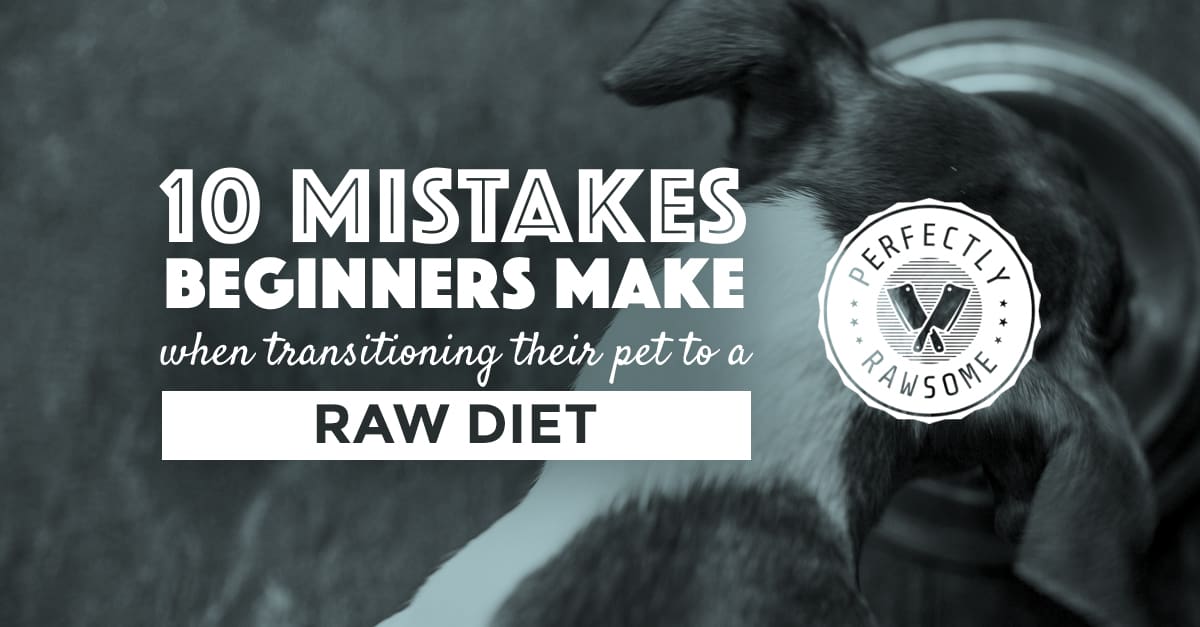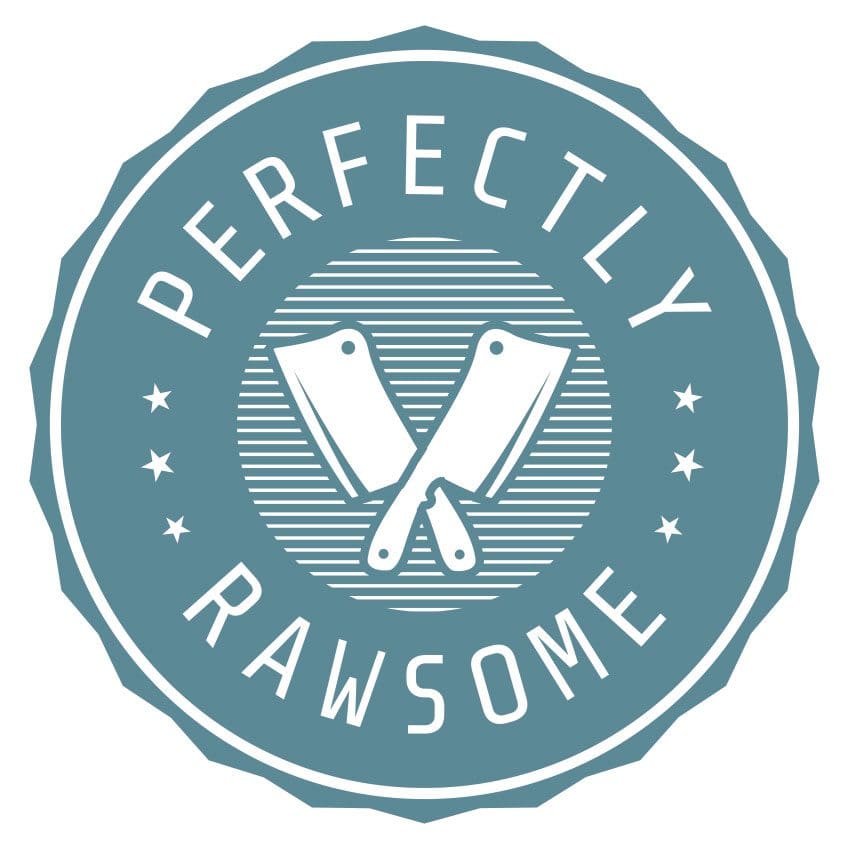There is a learning curve when beginning to feed a raw diet. Not only is the pet going through a diet transition, but the pet parent is also learning a new way to feed their companion. More often than not, beginners make mistakes when transitioning their pet to a raw diet. While mistakes are natural, they are best corrected as soon as possible.
It’s normal to get excited and want to push forward with raw feeding. However, it is recommended to take the transition slowly to avoid any unwanted stress. Many beginners make common mistakes such as:
Incomplete Homework
Did not complete enough research about raw feeding.
Rushing The Transition
Quickly rushing through the transition phases.
Feeding Enhanced Meats
Purchasing and feeding seasoned and enhanced meats.
Not Feeding Bone
Not adding enough raw meaty bones to the diet.
Feeding Too Much Bone
Feeding too much raw meaty bone.
Feeding Unsafe Bones
Providing inappropriate and unsafe bones.
Introducing New Foods Too Fast
Adding too many new foods to the diet too fast.
Oversupplementing
Adding too many unnecessary supplements to the diet.
Overcomplicating Things
Over complicating the calculations for feeding amounts.
Becoming Overwhelmed
Becoming frustrated and overwhelmed.
Home preparing a raw diet does have a learning curve and there is a lot of information to research, read, and retain. Before jumping into raw feeding, it’s important to gain the knowledge necessary to avoid the 10 mistakes beginners make when transitioning to raw feeding.

Incomplete Homework
It is not recommended to dive into raw feeding after learning about it 30-minutes ago. Take time, gain knowledge, understand the pet’s individual needs, and find local resources before beginning the raw feeding transition. Raw feeding can only be done if the necessary homework has been completed. This means research is required before taking the plunge. Gain an understanding of raw diets, how much pets will need to eat daily, and sourcing availability.
Rushing The Adult Transition
It’s normal to get excited and want to push forward when starting raw feeding! However, it is best to allow the adult pet to set the pace of the raw transition. Some pets take effortlessly to raw feeding, while others need more time and adjustments. Do not try to recreate meals from online photos – perspective in photos may not accurately portray ingredient amounts. Follow the transition guide, be patient, and the pet will be transitioned to raw in due time.
The raw feeding transition outlines a step-by-step process to transition adult dogs and cats to a raw diet. Each week was created to slowly move adult pets from a processed diet to a fresh food diet. It’s important to take the transition seriously and do not rush the process. However, this only applies to adult dogs and cats. Puppies and kittens require a fully balanced raw diet from the very beginning.
Most puppies and kittens take right to a fully balanced raw diet easily, although some young pets may be more sensitive to diet changes. If a slow transition is needed for a puppy or kitten, it is recommended to use a premade grind that is balanced to AAFCO for All Life Stages.
Feeding Enhanced Meats
Sodium is an essential micronutrient for dogs and cats. However, excessive amounts of sodium can result in dehydration, diarrhea, or sodium ion poisoning in extreme cases.
Some grocery store raw meats are injected with a sodium and nitrate solution. Always check the label of the raw product before purchasing. Ensure grocery store meats are 100mg sodium per 4oz (114g) serving size or less, although seafood will naturally be higher. Do not buy anything that is enhanced with flavoring, seasonings, broth, sugar, or with any other additives.
Commonly enhanced meats are chicken, turkey, duck, and pork products. If a label is not provided, ask the butcher for more information on the sodium content.
Not Feeding Bone
A common misconception is that “bones are dangerous because they splinter and have no nutritional value”. Due to this myth, many pet parents are scared to feed their dog or cat raw meaty bones. This is incredibly inaccurate because raw meaty bones are soft, easy to digest, and safe for pets to eat when the appropriate bones are selected for the individual pet. Bones are a primary source of calcium and phosphorus for maintenance of the skeletal system. The by-product of digested raw bones is the bulk that creates firm stool.
Cooked, smoked, and dehydrated bones are dangerous, and this is where the myth originates. These bones are dry and brittle from cooking which can cause them to splinter. The very act of cooking bones changes the structure of the bone and removes moisture. These bones should never be fed.
When feeding raw bones, the starting guideline is 10% edible bone for dogs and 6% for cats. These are only a guideline and some pets may need more or less bone content in order to maintain firm, consistent stools. Be sure to monitor the pet’s stool in the transition stage to get an understanding of how much bone they require.
Feeding Too Much Bone
Too much bone can cause complications ranging from constipation to undigested bone fragments in stool and vomit. When beginning the raw feeding transition, it is ok to provide slightly higher bone content than the recommended guideline for the first couple of days. This will help during the diet change. However, it is important to decrease the amount of bone to recommended guidelines if the pet is producing dry, crumbly, very hard, or chalky stools.
Providing Unsafe Bones
When providing larger raw bones than a pet can handle, they may not actually consume the bone, but rather strip the meat off of the bone. This is fine as it does provide mental enrichment and teeth cleaning benefits. However, the pet will be missing out on the important nutrient bones are used for – calcium!
There is a wide variety of raw bones that can be fed in a raw diet. However, it is important to provide the correct options for the size of the pet and to avoid weight-bearing bones. Small dogs, cats, and ferrets require soft bones from quail, Cornish hen, rabbit, duck and chicken. Medium to large dogs can have bones from chicken, duck, turkey, pork, and more.
Weight-bearing recreational bones or “wreck-reational” bones are found in large grazing animals. These bones often cause fractures to the teeth or jaw. Additionally, if large pieces are ingested, an intestinal blockage could occur as these bones are often too dense to digest. However, these bones are wonderful for making bone broth!
Examples of common weight-bearing bones include femurs, tibias, marrow bones, and knee joints from large grazing animals such as beef, bison, venison, and more.
Introducing New Foods Too Fast
Once an adult pet is on a raw diet, finding new proteins they have never eaten is very exciting! While puppies and kittens need a varied and balanced diet from the beginning, adding too many new foods at the same time can cause digestive upset for adult dogs and cats. Therefore, introduce new foods to adult pets one at a time. Some pets are sensitive to fat, while others may not tolerate specific proteins. When feeding anything new, provide a few ounces into a meal and monitor how they take to the new ingredient. If there is no sign of any negative reactions, then that is a sure sign to add more to the next meal!
Over Supplementing
Many pet parents believe that feeding a raw diet requires supplements because is not balanced. While some diets can certainly be imbalanced if the feeding guidelines are not followed properly; this does not mean that all raw diets are unbalanced. This notion has pet parents believing in the need for constant supplementation and multivitamins. Over supplementation can be just as detrimental as nutrient deficiencies. Nutrient overdose can cause a list of issues ranging from GI upset to hypervitaminosis.
More often than not, pet parents believe they need to purchase supplements for their pet’s diet to ensure nutritional balance. There is no need to buy multivitamins however. For every amino acid, fatty acid, vitamin, and mineral a pet needs there is a whole food that provides it! It is possible to balance a raw diet without any supplements. Absorption rates are lower with supplements, but the body knows what to do with food. Nutrients are digested, absorbed, and metabolized at a much higher rate when provided in their natural state – fresh whole foods.
Overcomplicating Things
It is easy to get swept away in raw feeding because pet parents want the best for their pet. However, raw feeding is not rocket science nor does it have to be. This only causes frustration which could ultimately cause pet parents to give up.
The foundation of a raw diet is based on whole, wild prey. When looking at prey animals that a wild dog or cat would consume, this information can be used to provide a similar diet without requiring pets to hunt for food. Prey animals consist of meat, bone, organs, and roughage from the pelt/feathers. PMR and BARF model guidelines were created to mimic this whole prey. However, the guidelines are not hard and fast rules. They are only starting points when feeding raw. Wild canids also typically consume a variety of other foods than just prey. Therefore, achieving a balanced raw diet is more than just the ratio guidelines alone.
Additionally, when calculating how much to feed do not get caught up in exact decimal points. This is very tedious and time-consuming – a tenth of a decimal point is not going to adversely affect nutritional balance.
Examples:
If calculations are 1.43oz of liver, round up to 1.5oz
If calculations are 42.78g of liver, round up to 43g
Becoming Overwhelmed
While research is needed to begin raw feeding, the internet is a deep and vast place and the information on how to feed raw varies far and wide. It is often hard to know what advice to listen to. All the conflicting advice itself is enough to make pet parents give up on raw feeding before even starting. Try not to get swept away in the overwhelming amount of information the Internet has in regards to raw feeding. It is recommended to choose one qualified source of information, and stick to it.
For additional help with feeding raw, Perfectly Rawsome has a Facebook group dedicated to helping pet parents feed raw. Raw Feeding University (RFU) is a worldwide online community for raw feeders to ask questions, connect, and share experiences. The admin team and group members are here to help every step of the way, so do not be afraid to ask questions!
CLOSING COMMENTS
It is normal to get excited and want to push forward, but avoid rushing the transition process. The raw feeding transition is divided into phases to slowly move adult dogs and cats from a processed diet to a fresh food diet. Simple meals are provided in the beginning and new ingredients are slowly added over the course of a few weeks to achieve a full varied diet. Therefore, this means the transition meals are not balanced and should not be fed indefinitely. Additionally, the adult transition is not appropriate for puppies and kittens due to being unbalanced. It is best to allow adult pets to set the pace and adjust to their individual needs. Some pets take effortlessly to raw, while others need more time.
Mistakes will happen, but following the step-by-step transition into raw feeding will help set everyone up for success. It would be ideal for all dogs and cats to be on a raw diet, but pet parents also need to feel confident in the process. Following the transition guide for adult dogs, feeding puppies raw guide, and the slow transition guide for picky cats is the best way to transition pets to a raw diet.
